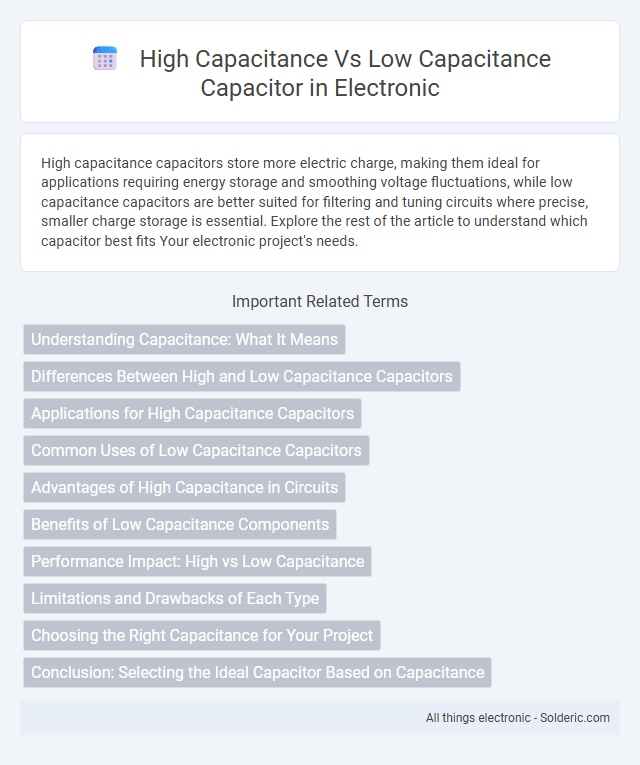High capacitance capacitors store more electric charge, making them ideal for applications requiring energy storage and smoothing voltage fluctuations, while low capacitance capacitors are better suited for filtering and tuning circuits where precise, smaller charge storage is essential. Explore the rest of the article to understand which capacitor best fits Your electronic project's needs.
Comparison Table
| Aspect | High Capacitance Capacitor | Low Capacitance Capacitor |
|---|---|---|
| Capacitance Value | Typically above 1 uF | Typically below 1 uF |
| Applications | Energy storage, power smoothing, audio filters | High-frequency signal filtering, timing circuits |
| Physical Size | Larger due to greater charge storage | Smaller and compact |
| Frequency Response | Lower frequency range | Better performance at high frequencies |
| Equivalent Series Resistance (ESR) | Higher ESR, affecting efficiency | Lower ESR, suitable for high-speed circuits |
| Cost | Generally higher | Generally lower |
| Common Types | Electrolytic, supercapacitors | Ceramic, film capacitors |
Understanding Capacitance: What It Means
Capacitance measures a capacitor's ability to store electrical charge, directly influenced by its plate area, dielectric material, and distance between plates. High capacitance capacitors store more charge at a given voltage, making them ideal for energy storage and smoothing applications, while low capacitance capacitors excel in high-frequency circuits due to faster charge and discharge cycles. Understanding capacitance helps engineers select the right capacitor type to optimize circuit performance and energy efficiency.
Differences Between High and Low Capacitance Capacitors
High capacitance capacitors store more electric charge due to their larger surface area or thinner dielectric, making them suitable for energy storage and smoothing applications in power supplies. Low capacitance capacitors offer faster charging and discharging rates with lower energy storage, ideal for high-frequency circuits and signal filtering. Materials, physical size, and applications significantly differentiate high capacitance capacitors from low capacitance types, impacting performance and efficiency.
Applications for High Capacitance Capacitors
High capacitance capacitors are crucial in applications requiring large energy storage and smooth power delivery, such as in power supply filtering, audio equipment, and energy harvesting systems. They stabilize voltage in electrical circuits by minimizing voltage fluctuations and providing a steady energy reserve in devices like electric vehicles and renewable energy systems. Their ability to store significant charge makes them essential for applications demanding high transient currents and long discharge times.
Common Uses of Low Capacitance Capacitors
Low capacitance capacitors are commonly used in high-frequency applications such as RF circuits, signal processing, and timing devices due to their ability to maintain stability and reduce signal distortion. These capacitors excel in filtering high-frequency noise, coupling and decoupling signals, and frequency tuning in oscillators. Your electronic designs benefit from their precise charge storage and fast response, essential for reliable performance in communication and signal integrity tasks.
Advantages of High Capacitance in Circuits
High capacitance capacitors store larger amounts of electrical charge, enabling more effective smoothing and filtering in power supply circuits, which reduces voltage ripple and noise. Their ability to maintain stable voltage levels improves the performance and reliability of electronic devices, especially in applications requiring energy storage or transient voltage suppression. High capacitance components also support longer energy discharge times, beneficial for backup power and timing functionalities.
Benefits of Low Capacitance Components
Low capacitance capacitors offer faster charge and discharge cycles, making them ideal for high-frequency applications such as RF circuits and signal processing. They minimize energy losses and reduce noise, improving overall circuit performance and precision. These components also tend to have smaller physical sizes, enabling compact and lightweight electronic device designs.
Performance Impact: High vs Low Capacitance
High capacitance capacitors store more charge, enabling better energy storage and smoother voltage regulation in power supply circuits. Low capacitance capacitors excel in high-frequency applications due to their faster charge-discharge cycles and reduced parasitic effects, improving signal integrity. Selecting between high and low capacitance impacts circuit stability, response time, and noise filtering efficiency based on the application's frequency and power demands.
Limitations and Drawbacks of Each Type
High capacitance capacitors often face limitations such as increased physical size, higher leakage currents, and slower response times, which can hinder their performance in high-frequency circuits. Low capacitance capacitors, while offering faster switching speeds and smaller form factors, typically struggle with insufficient energy storage and reduced filtering effectiveness in power supply applications. Both types require careful selection to balance capacitance value, size, and electrical characteristics based on specific circuit requirements.
Choosing the Right Capacitance for Your Project
Selecting the appropriate capacitance value depends on the application's voltage and frequency requirements, as high capacitance capacitors store more charge and are ideal for energy storage or smoothing power supply fluctuations. Low capacitance capacitors excel in filtering high-frequency noise and signal coupling due to their faster charge-discharge cycles and lower reactance at high frequencies. Matching capacitance with circuit parameters ensures optimal performance, stability, and efficiency in electronic designs.
Conclusion: Selecting the Ideal Capacitor Based on Capacitance
High capacitance capacitors store larger amounts of electrical charge, making them ideal for applications requiring significant energy storage or smoothing of power supply fluctuations. Low capacitance capacitors, with quicker charge and discharge cycles, are suited for high-frequency filtering and signal coupling tasks. Selecting the ideal capacitor depends on matching capacitance values to circuit requirements, ensuring optimal performance and efficiency in electronic designs.
high capacitance vs low capacitance capacitor Infographic

 solderic.com
solderic.com